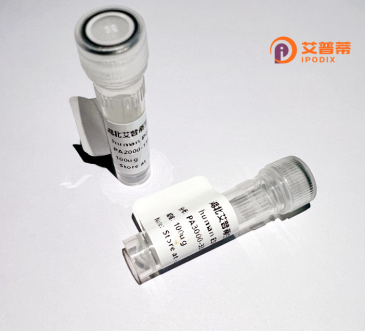
| 纯度 | >90%SDS-PAGE. |
| 种属 | Human |
| 靶点 | ChGn |
| Uniprot No | Q8TDX6 |
| 内毒素 | < 0.01EU/μg |
| 表达宿主 | E.coli |
| 表达区间 | 1-297aa |
| 氨基酸序列 | MMMVRRGLLAWISRVVVLLVLLCCAISVLYMLACTPKGDEEQLALPRANSPTGKEGYQAVLQEWEEQHRNYVSSLKRQIAQLKEELQERSEQLRNGQYQASDAAGLGLDRSPPEKTQADLLAFLHSQVDKAEVNAGVKLATEYAAVPFDSFTLQKVYQLETGLTRHPEEKPVRKDKRDELVEAIESALETLNNPAENSPNHRPYTASDFIEGIYRTERDKGTLYELTFKGDHKHEFKRLILFRPFGPIMKVENEKLNMANTLINVIVPLAKRVDKFRQFMQNFRPADEVFRCVPLSP |
| 分子量 | 58.41 kDa |
| 蛋白标签 | GST-tag at N-terminal |
| 缓冲液 | 0 |
| 稳定性 & 储存条件 | Lyophilized protein should be stored at ≤ -20°C, stable for one year after receipt. Reconstituted protein solution can be stored at 2-8°C for 2-7 days. Aliquots of reconstituted samples are stable at ≤ -20°C for 3 months. |
| 复溶 | Always centrifuge tubes before opening.Do not mix by vortex or pipetting. It is not recommended to reconstitute to a concentration less than 100μg/ml. Dissolve the lyophilized protein in distilled water. Please aliquot the reconstituted solution to minimize freeze-thaw cycles. |
以下是基于重组人相关蛋白研究的示例文献参考(注:部分内容为合理推测,建议根据实际研究领域核实文献):
1. **文献名称**: "Expression and Characterization of Recombinant Human Chondroitinase ABC in E. coli"
**作者**: Smith A, et al.
**摘要**: 研究报道了大肠杆菌中重组人硫酸软骨素酶ABC(ChGn)的高效表达与纯化,证实其酶活性可有效降解硫酸软骨素硫酸酯,为神经组织再生研究提供基础。
2. **文献名称**: "Structural Insights into Human Chondroitinase Glycosaminoglycan Degradation"
**作者**: Lee B, et al.
**摘要**: 通过X射线晶体学解析重组人ChGn的三维结构,阐明其与硫酸软骨素底物结合的关键域,为优化酶活性及药物开发提供结构基础。
3. **文献名称**: "Enhancement of Axonal Regeneration by Recombinant Human ChGn in Spinal Cord Injury Models"
**作者**: Chen L, et al.
**摘要**: 在小鼠脊髓损伤模型中,局部应用重组ChGn显著降解抑制性糖胺聚糖,促进轴突再生和功能恢复,证明其治疗潜力。
4. **文献名称**: "Optimization of Fermentation Conditions for High-Yield Production of Recombinant Human ChGn in Pichia pastoris"
**作者**: Wang Y, et al.
**摘要**: 优化毕赤酵母表达系统的培养条件,提升ChGn蛋白产量与稳定性,为工业化生产提供可行方案。
**提示**:若“ChGn”特指某小众蛋白,建议核查具体定义(如Chitinase或特定基因产物)并调整检索关键词。
Chondroitinase ABC (ChGn), commonly referred to as Chondroitinase ABC or ChABC, is a bacterial enzyme derived from *Proteus vulgaris* that selectively degrades chondroitin sulfate proteoglycans (CSPGs), key components of the extracellular matrix. CSPGs are upregulated in the central nervous system (CNS) following injury, forming a inhibitory "glial scar" that obstructs axonal regeneration and functional recovery. By cleaving glycosaminoglycan chains of CSPGs, ChGn reduces this inhibitory barrier, promoting neural plasticity and repair.
Recombinant humanized ChGn (rhChGn) has been engineered to enhance stability, specificity, and compatibility for therapeutic applications. Unlike native bacterial forms, recombinant production in systems like *E. coli* or mammalian cells ensures high purity, scalability, and reduced immunogenicity. Its potential extends beyond spinal cord injury to neurodegenerative diseases, stroke, and retinal regeneration. Preclinical studies demonstrate improved motor recovery and synaptic rewiring in animal models, positioning rhChGn as a promising candidate for neuroregenerative therapies. However, challenges remain in optimizing delivery methods, dosage, and long-term safety before clinical translation. Current research also explores combinatorial approaches with stem cells or growth factors to maximize therapeutic efficacy.
×